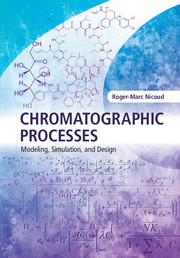Book contents
- Frontmatter
- Contents
- Preface and acknowledgments
- 1 Our approach to modeling chromatographic processes
- 2 Linear chromatography: the Russian Lego
- 3 Non-linear chromatography: equilibrium theory
- 4 Fluid–solid phase equilibria
- 5 Mass transfer
- 6 Hydrodynamics of chromatographic columns
- 7 Simulating chromatographic columns
- 8 Counter-current systems
- 9 Chromatographic modes and their optimization
- 10 Addressing a few industrial problems
- 11 Conclusion
- Appendix A Some important properties of the Laplace transform
- Appendix B Inlet and outlet boundary conditions
- Appendix C Equilibrium theory: single-solute chromatograms
- Appendix D Equilibrium theory: binary chromatograms
- Appendix E The influence of the porosity determination on chromatographic modeling
- Appendix F Useful physico-chemical data and orders of magnitude
- Appendix G Fick and Maxwell–Stefan approaches to diffusion
- Appendix H Non-linear LDF for multi-solute systems
- Appendix I Situations that make the use of the MC model problematic
- Appendix J Typical industrial chromatographic processes
- Notation
- Index
- References
1 - Our approach to modeling chromatographic processes
Published online by Cambridge University Press: 05 April 2015
- Frontmatter
- Contents
- Preface and acknowledgments
- 1 Our approach to modeling chromatographic processes
- 2 Linear chromatography: the Russian Lego
- 3 Non-linear chromatography: equilibrium theory
- 4 Fluid–solid phase equilibria
- 5 Mass transfer
- 6 Hydrodynamics of chromatographic columns
- 7 Simulating chromatographic columns
- 8 Counter-current systems
- 9 Chromatographic modes and their optimization
- 10 Addressing a few industrial problems
- 11 Conclusion
- Appendix A Some important properties of the Laplace transform
- Appendix B Inlet and outlet boundary conditions
- Appendix C Equilibrium theory: single-solute chromatograms
- Appendix D Equilibrium theory: binary chromatograms
- Appendix E The influence of the porosity determination on chromatographic modeling
- Appendix F Useful physico-chemical data and orders of magnitude
- Appendix G Fick and Maxwell–Stefan approaches to diffusion
- Appendix H Non-linear LDF for multi-solute systems
- Appendix I Situations that make the use of the MC model problematic
- Appendix J Typical industrial chromatographic processes
- Notation
- Index
- References
Summary
Let's start the journey …
The title of this book contains the words processes, modeling, simulation and design. Let us start by briefly commenting on their respective meanings.
According to the dictionary, the word process has a double meaning as it can refer to either:
• a series of actions that produce a change or development (e.g. the process of digestion)
• a method of doing or producing something (e.g. the Bessemer process for the mass production of steel).
In order to clarify the distinction, let us consider that the first definition refers to elementary processes while the second refers to manufacturing processes. When speaking of chromatographic processes, one can refer either to elementary processes (the physicochemical mechanisms at the origin of the separation) or to manufacturing processes (like the Parex© process for producing para-xylene).
The thesis of this book is that understanding elementary processes is of primary importance for properly designing manufacturing processes.
The difference between modeling and simulation may be less obvious for many chromatographers. By modeling, we mean the task of understanding and predicting processes (either elementary or manufacturing). By simulation, we mean the task of actually representing and quantitatively evaluating a process; this is typically associated with more or less complex numerical tools. A good simulator based on a poor model will give wrong predictions (e.g. simulating ion-exchange processes without taking into account electroneutrality constraints). A good model without a simulator can give useful information and trends (e.g. the equilibrium model neglecting all sources of hydrodynamic dispersion and mass transfer limitations, as presented in Chapter 3). With a good simulator in hand, one can then address the final step, consisting of designing the manufacturing process.
A good example of what modeling can do for the chromatographer is the determination of flow rates in simulated moving beds. I used to say that finding these parameters is like finding a small piece of blue in a dark sky: for the vast majority of flow rates, the SMB delivers “purified” fractions having the composition of the feed, and is thus totally inefficient.
Information
- Type
- Chapter
- Information
- Chromatographic ProcessesModeling, Simulation, and Design, pp. 1 - 19Publisher: Cambridge University PressPrint publication year: 2015
